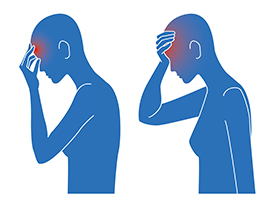Migraines: Everything You Need to Know

Migraines aren’t as common as an ordinary headache. However, they pose a significant problem for millions of individuals today. Roughly, 35 million Americans suffer with migraine symptoms, with a large portion of those individuals being middle-aged women. In fact, migraines rank third on the list of prevalent illnesses throughout the world. One out of every four households have someone who gets an occasional migraine.
Migraines can cause a tremendous amount of pain, digestive problems and sensitivity to light and noise. Thankfully, there are a number of different things that you can do to end your suffering naturally. While some only suffer with one of these headaches on a rare occasion, others end up dealing with them more often than not. All headaches tend to have the same underlying causes, such as increased stress levels, increased inflammation and changes in your neurotransmitter levels. Migraines often peak for people in their 30s, worsen during transitional periods and run in families.
Symptoms Associated with Migraines
Migraine symptoms tend to vary from one individual to another. There are four stages of migraine symptoms: prodrome, aura, headache and postdrome. The stages outline the transition from the first symptoms and signs of migraines, into the intense pain and then through the stage where pain starts to decline, while still lingering. Some of the common migraine symptoms are:
- Loss of appetite, nausea and an upset stomach
- Increased sensitivity to light and sound
- Severe pounding on either one or both sides of you head
- Irritability
- Blurred vision, flashing lights or unusual lines and shapes
- Shakiness and dizziness
- Increased thirst
- Weakness or numbness in your face and neck muscles
- Trouble concentrating, holding a conversation and speaking normally
Before having a migraine attack, some individuals will have a sense that a migraine is actually coming. Their vision starts to become impaired, their heads start throbbing and their stomachs start churning. It isn’t long after that when the full-blown migraine kicks in and takes over. Some suffer with migraines every week or even several days at a time, while others only get them once or twice per month.
Causes of Migraines
Migraines tend to occur for a number of different reasons. Some of the more common ones are:
- A lack of sleep
- Dysfunction in your brain stem attributing to illness or injury
- Hormonal changes affected by a health condition or poor diet
- Stress
- Changes in your neurotransmitter levels and nerve signals causing pain
- Increased inflammation affecting normal blood flow
- Reaction to medication
- Genetic susceptibility
It doesn’t matter what the underlying cause of your migraine is, the key is figuring out what you can do to overcome the pain and get the relief you need. Migraines can take control of your life and leave you feeling stressed and unable to do anything more than lie down and wait for the pain to subside. By taking a few extra precautions, you can help to minimize some of the migraine symptoms and enjoy having the relief you need.

 de
de el
el









